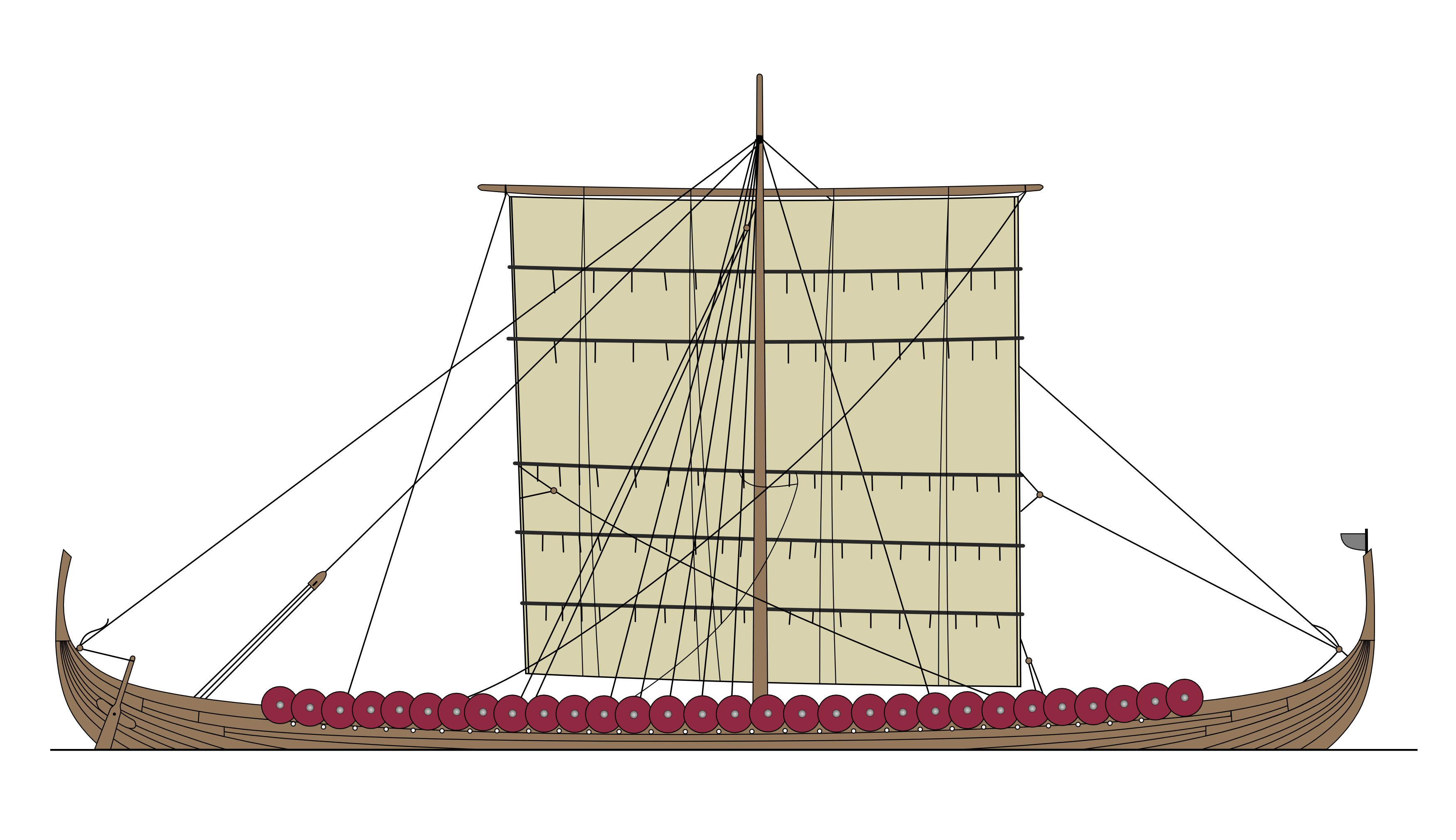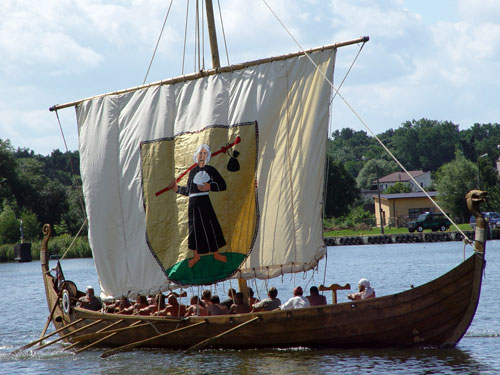|
Karve (ship)
Karves (or Karvi) were a small type of longship with broad hull, somewhat similar to the ocean-going knarr cargo ships. Karves were used for both war and ordinary transport, carrying people, goods or livestock. Because they were able to navigate in very shallow water, they were also used for coasting Coasting may refer to: * Coasting (vehicle), performing a natural deceleration of a motor when the power is removed * Carrying out a part of a spaceflight without orbital maneuver * Sledding * Performing ovarian hyperstimulation without inducing .... Karves had broad beams of approximately , were up to in length, and allowed for up to 16 oars. The Tune ship from Norway is an example of a historical Karve ship. Notes Viking ships Merchant sailing ship types Naval sailing ship types {{ship-type-stub ... [...More Info...] [...Related Items...] OR: [Wikipedia] [Google] [Baidu] |
Longship
Longships were a type of specialised Scandinavian warships that have a long history in Scandinavia, with their existence being archaeologically proven and documented from at least the fourth century BC. Originally invented and used by the Norsemen (commonly known as the Vikings) for commerce, exploration, and warfare during the Viking Age, many of the longship's characteristics were adopted by other cultures, like Anglo-Saxons, and continued to influence shipbuilding for centuries. The longship's design evolved over many centuries, and continuing up until the sixth century with clinker-built ships like Nydam. The longship appeared in its complete form between the ninth and 13th centuries. The character and appearance of these ships have been reflected in Scandinavian boatbuilding traditions to the present day. The particular skills and methods employed in making longships are still used worldwide, often with modern adaptations. They were all made out of wood, with cloth sails ... [...More Info...] [...Related Items...] OR: [Wikipedia] [Google] [Baidu] |
Knarr
A knarr is a type of Norse merchant ship used by the Vikings. The knarr ( non, knǫrr, plural ) was constructed using the same clinker-built method as longships, karves, and faerings. History ''Knarr'' is the Old Norse term for a type of ship built for long sea voyages and used during the Viking expansion. The knarr was a cargo ship; the hull was wider, deeper and shorter than a longship, and could take more cargo and be operated by smaller crews. They were built with a length of about , a beam of , and a hull capable of carrying up to 24 tons. by It was primarily used to transport trading goods like w ... [...More Info...] [...Related Items...] OR: [Wikipedia] [Google] [Baidu] |
Coasting
Coasting may refer to: * Coasting (vehicle), performing a natural deceleration of a motor when the power is removed * Carrying out a part of a spaceflight without orbital maneuver * Sledding * Performing ovarian hyperstimulation without inducing ovulation with human chorionic gonadotropin (hCG) Books * Coasting (book), a travel book by Jonathan Raban Music *"Coasting", song by A Band Called O A Band Called O were a band from Jersey, Channel Islands. Originally known as The Parlour Band, playing progressive rock, they renamed to A Band Called O for two albums on CBS/Epic and later to The O Band for further albums with UA. Despite is ... *"Coasting", song by Free All Angels from There's a Star *"Coasting", song by Great Gable from Tracing Faces See also * Coast (other) {{Disambiguation ... [...More Info...] [...Related Items...] OR: [Wikipedia] [Google] [Baidu] |
Beam (nautical)
The beam of a ship is its width at its widest point. The maximum beam (BMAX) is the distance between planes passing through the outer extremities of the ship, beam of the hull (BH) only includes permanently fixed parts of the hull Hull may refer to: Structures * Chassis, of an armored fighting vehicle * Fuselage, of an aircraft * Hull (botany), the outer covering of seeds * Hull (watercraft), the body or frame of a ship * Submarine hull Mathematics * Affine hull, in affi ..., and beam at waterline (BWL) is the maximum width where the hull intersects the surface of the water. Generally speaking, the wider the beam of a ship (or boat), the more initial stability it has, at the expense of secondary stability in the event of a capsize, where more energy is required to right the vessel from its inverted position. A ship that heels on her ''beam ends'' has her deck beams nearly vertical. Typical values Typical length-to-beam ratios ( aspect ratios) for small sailboats are fro ... [...More Info...] [...Related Items...] OR: [Wikipedia] [Google] [Baidu] |
Tune Ship
The Tune ship (''Tuneskipet'') is a Viking ship exhibited in the Viking Ship Museum (''Vikingskipshuset på Bygdøy'') in Bygdøy, Oslo. The Tune ship is of the karve, a small type of longship with broad hull. It was found at the Haugen farm on the island of Rolvsøy in the parish of Tune in Viken, Norway. It was discovered in a ship burial mound (''Båthaugen'', from the Old Norse words ''båt'' meaning boat and ''haugr'' meaning mound or barrow). It was discovered when the burial mound was opened and the site was excavated by archaeologist Oluf Rygh in 1867. It was named the Tune ship by Professor Rygh after excavation. This is due to the discovery being located in Tune parish. The Tune ship is fragmentary, but may have been up to long. It is wide and would have had 11 or 12 pairs of oars. The length of the keel is approximately . The ship was built around AD 900. It was made principally of clinkered oak planks. It is of rugged construction with naturally grown ribs, ... [...More Info...] [...Related Items...] OR: [Wikipedia] [Google] [Baidu] |
Viking Ships
Viking ships were marine vessels of unique structure, used in Scandinavia from the Viking Age throughout the Middle Ages. The boat-types were quite varied, depending on what the ship was intended for, but they were generally characterized as being slender and flexible boats, with symmetrical ends with true keel. They were clinker built, which is the overlapping of planks riveted together. Some might have had a dragon's head or other circular object protruding from the bow and stern for design, although this is only inferred from historical sources. Viking ships were used both for military purposes and for long-distance trade, exploration and colonization. In the literature, Viking ships are usually seen divided into two broad categories: merchant ships and warships, the latter resembling narrow "war canoes" with less load capacity, but higher speed. However, these categories are overlapping; some transport ships would also form part of war fleets. As a rule, ship lanes in Scandin ... [...More Info...] [...Related Items...] OR: [Wikipedia] [Google] [Baidu] |
Merchant Sailing Ship Types
A merchant is a person who trades in commodities produced by other people, especially one who trades with foreign countries. Historically, a merchant is anyone who is involved in business or trade. Merchants have operated for as long as industry, commerce, and trade have existed. In 16th-century Europe, two different terms for merchants emerged: referred to local traders (such as bakers and grocers) and ( nl, koopman) referred to merchants who operated on a global stage, importing and exporting goods over vast distances and offering added-value services such as credit and finance. The status of the merchant has varied during different periods of history and among different societies. In modern times, the term ''merchant'' has occasionally been used to refer to a businessperson or someone undertaking activities (commercial or industrial) for the purpose of generating profit, cash flow, sales, and revenue using a combination of human, financial, intellectual and physical capital ... [...More Info...] [...Related Items...] OR: [Wikipedia] [Google] [Baidu] |
.jpg)



